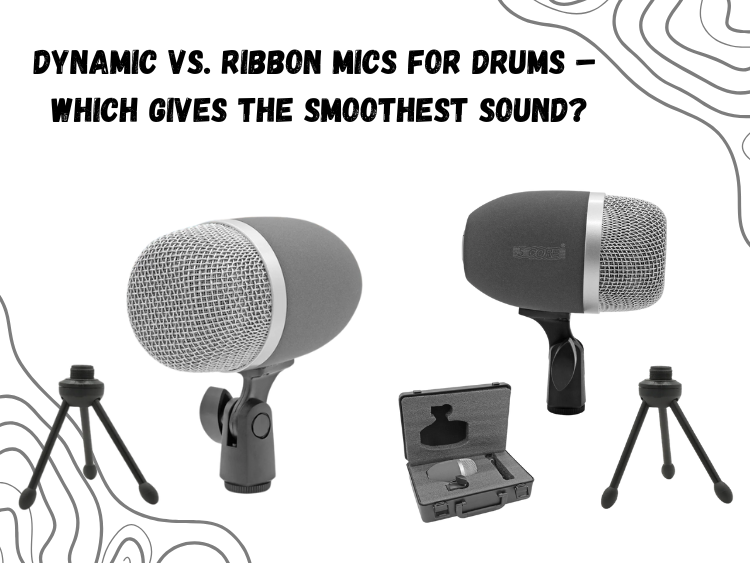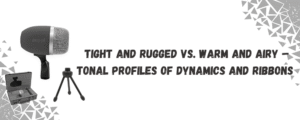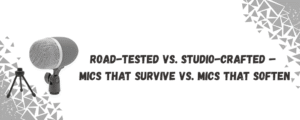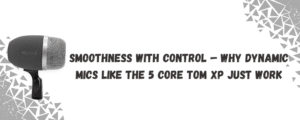When you’re recording drums, smoothness can be elusive. Harsh cymbals, boxy snares, and brittle room tone—most of us have been there. And sooner or later, the mic debate creeps in: Do you go with rugged dynamics, or try your luck with silky ribbon mics?
This isn’t just another gear comparison. It’s about choosing the right tool to get the smooth drum sound you actually want. Let’s break it down.
The Character of Each Mic
Start with how they’re built.
Dynamic microphones are tough. Designed to handle high sound pressure, they’re staples in live gigs and tracking rooms alike. Most kick, snare, and tom recordings rely on them for a reason—they punch hard and don’t flinch under volume.
The 5 Core Tom XP is a textbook example. Tailored for drums, it keeps things tight without choking the tone. It handles heat and still sounds clean, even when you’re laying into your kit.
Ribbon mics are different. They capture detail with a softness that condensers and dynamics don’t always manage. There’s no harsh top-end here—just warm, natural transients and a room tone that actually feels like the space you’re in. That’s why so many engineers reach for ribbons when they want their drums to breathe.
So, Which One Sounds Smoother?
It depends on where you’re putting the mic and what you mean by smooth.
If you’re close-miking—kick, snare, toms—dynamics are smoother in practice. They control the chaos. You’re not fighting cymbal bleed, and the tone stays focused. No extra processing to fix harshness, no weird peaks from a slightly off placement.
With something like the 5 Core Tom XP, that control becomes part of the sound. It doesn’t overhype the attack or kill the body. You get thump, depth, and a usable tone right out of the gate.
But if you’re working with overheads or room mics? Ribbon mics shine there. They tame splashy cymbals. They give your drum kit a natural roll-off that smooths everything out. And they do it without making your mix feel dull. That’s the kind of smooth that’s hard to replicate.
Durability and Use in Real Setups
Ribbons are fragile. No sugarcoating that.
They can’t handle heavy-handed drummers up close. They don’t like phantom power. And they definitely don’t belong on stage unless you’re rolling with a careful crew and a padded case.
That’s where dynamic mics win hard. You drop them? They work. You crank the preamp? They hold up. That’s not a bonus—it’s essential. If you’re playing shows, rehearsing loud, or just want a mic that won’t flake on you, dynamics are the obvious pick.
The Tom XP is built exactly for that. It’s not trying to be delicate. It’s built for impact, literally.
Cost vs. Outcome
If you’re going ribbon, be prepared to spend—and handle them with care. And often, to really unlock that ribbon character, you’ll need a decent preamp with a clean boost.
But with a good dynamic mic like the Tom XP, you can plug in and go. It gives you a clean, rounded tone right off the bat. Not “vintage warm,” but not sterile either. And if you need more, a little EQ or compression gets you there fast.
For drummers who want something reliable without spending a fortune, this is the better starting point.
Also worth looking at is this 5 Core drum mic kit. Seven pieces, made for drummers—not studio engineers. You get everything you need, and the tone holds up.
Real-World Takeaway
If you’ve got a great-sounding room, the time to position carefully, and want a rich, natural overhead sound—ribbons are worth exploring.
But for close-miking or gigging, dynamics win on practicality, tone, and price. They’re easier to use. Easier to mix. Easier to trust.
For drummers who just want a clean, controlled tone without adding ten steps to the process, the 5 Core Tom XP just makes sense.
Because sometimes, smooth isn’t about softness. It’s about control.




